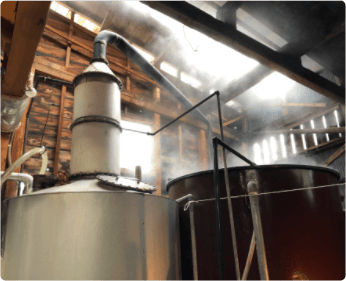Koji has been used in traditional Japanese fermentation for millennia and Japanese alcohol making for more than 1,200 years. Without koji, soy sauce, miso, sake, and our spirits portfolio would not exist. This unique fermentation process creates umami-laden spirits with a character unique to Japan. While shochu and awamori could be made anywhere in the world, Japan created these spirits traditions over 500 years ago by adapting sake making methods to distillation.
Koji is the national mold of Japan. It may seem odd that a country has a national mold. It may seem nearly as odd that we are leading off the first issue of our spirits company’s seasonal brain dump with a mold. But we simply love the stuff. It would not be too much to say that Japanese cuisine as we know it would not exist without koji. It’s used in the fermentation process for:

Soy Sauce

Mirin

Sake

Miso

Shochu

Awamori
While shochu and awamori are not well known outside of Japan, they are very popular in Japan. In fact, these indigenous spirits have outsold sake every year since 2003 and far outpace whisky in the domestic market. In fact, there is more shochu and awamori made in Japan every year than tequila in Mexico, but less than 1% of it is exported.

Barley koji fermentation
Honkaku (meaning authentic) Shochu and Ryukyu Awamori are always made with koji in a process known as multiple parallel fermentation in which the koji is converting starches from grains or other fementable ingredients into sugars so that yeast can turn those sugars into alcohol. Unlike beer or whisky making where grains are malted to extract sugars before those sugars are fermented, in sake, shochu, and awamori the koji and yeast are active in the same fermentation tank.

Traditional pot still
Koji is very good at its job. As such, these fermentations can reach over 20% alcohol, which is much higher than beer, wine, whisky, or other spirits fermentations prior to distillation. As a result, a single distillation of a koji fermentation can reach 37 to 45% alcohol and the resulting spirit is bursting with the flavors and aromas of the original base ingredient while being bolstered by umami flavors created during the koji fermentation process.
These koji-based spirits are almost always distilled only once and are most often matured in enamel lined stainless steel tanks that do not impart any flavor. The more traditional aging method is in unglazed ceramic pots, which allow the spirit to breathe and impart a slight minerality. Barrel aging is also a thing, though the oak can overwhelm the flavors and aromas so barrel aging is usually for relatively short periods of time.




